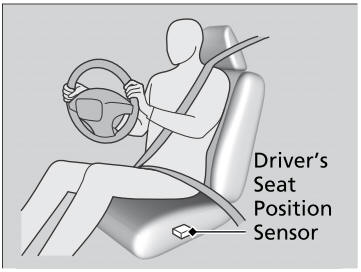Honda CR-V: When Driving / Tire Pressure Monitoring System (TPMS) - Required Federal Explanation (U.S. models)
Each tire, including the spare (if provided), should be checked monthly when cold and inflated to the inflation pressure recommended by the vehicle manufacturer on the vehicle placard or tire inflation pressure label.
(If your vehicle has tires of a different size than the size indicated on the vehicle placard or tire inflation pressure label, you should determine the proper tire inflation pressure for those tires.)
As an added safety feature, your vehicle has been equipped with a tire pressure monitoring system (TPMS) that illuminates a low tire pressure telltale

when one or more of your tires is significantly under-inflated. Accordingly, when the low tire pressure telltale illuminates, you should stop and check your tires as soon as possible, and inflate them to the proper pressure.
Driving on a significantly under-inflated tire causes the tire to overheat and can lead to tire failure. Under-inflation also reduces fuel efficiency and tire tread life, and may affect the vehicle's handling and stopping ability.
Please note that the TPMS is not a substitute for proper tire maintenance, and it is the driver’s responsibility to maintain correct tire pressure, even if under-inflation has not reached the level to trigger illumination of the TPMS low tire pressure telltale.
Your vehicle has also been equipped with a TPMS malfunction indicator to indicate when the system is not operating properly. The TPMS malfunction indicator is combined with the low tire pressure telltale. When the system detects a malfunction, the telltale will flash for approximately one minute and then remain continuously illuminated. This sequence will continue upon subsequent vehicle start-ups as long as the malfunction exists.
When the malfunction indicator is illuminated, the system may not be able to detect or signal low tire pressure as intended.
TPMS malfunctions may occur for a variety of reasons, including the installation of replacement or alternate tires or wheels on the vehicle that prevent the TPMS from functioning properly.
Always check the TPMS malfunction telltale after replacing one or more tires or wheels on your vehicle to ensure that the replacement or alternate tires and wheels allow the TPMS to continue to function properly.
 TPMS Calibration
TPMS Calibration
You must start TPMS calibration every time you:
Adjust the pressure in one or more tires.
Rotate the tires.
Replace one or more tires.
Before calibrating the TPMS:
Set the cold tire pressure in all four tires...
 Braking
Braking
When you depress the brake pedal, you may hear a
whirring sound from the engine compartment. This is
because the brake system is in operation, and it is
normal...
Other information:
Honda CR-V 2017-2025 Owner's Manual: Protecting Infants
An infant must be properly restrained in a rear-facing, reclining child seat until the infant reaches the seat manufacturer’s weight or height limit for the seat, and the infant is at least one year old. Positioning a rear-facing child seat Child seats must be placed and secured in a rear seating position...
Honda CR-V 2017-2025 Owner's Manual: Listening to Featured Channels
Suggested channel listing received from SiriusXM® can be displayed and selected. Select the open/close icon to display a channel list. Select the Channel tab. Select the featured channel list title you want to listen to. The selected channel list of the title is displayed...
Categories
- Manuals Home
- Honda CR-V Owners Manual
- Honda CR-V Service Manual
- Front Seats
- Compass Zone Selection
- Auto Idle Stop System ON/OFF
- New on site
- Most important about car
Advanced Airbags
The airbags have advanced features to help reduce the likelihood of airbag related injuries to smaller occupants.
The driver's advanced airbag system includes a seat position sensor.

